A recent article published in the Goodfruit Grower suggests that the use of calcium fertility inputs in tree fruit is a poor allocation of resources. The author makes the assertion that there is enough calcium in Eastern Washington soils to adequately supply all calcium needs and concludes that calcium fertilizers do not improve calcium content in fruit. Here’s some perspective.
A couple of points:
1. I have never met a grower who has been concerned about having too much calcium in their fruit. I would argue that any grower will have a good understanding that calcium is essential for successful storage of fruit, extending its shelf life and for the reduction of disorders. This study by Little and Holmes is a great illustration of this relationship.
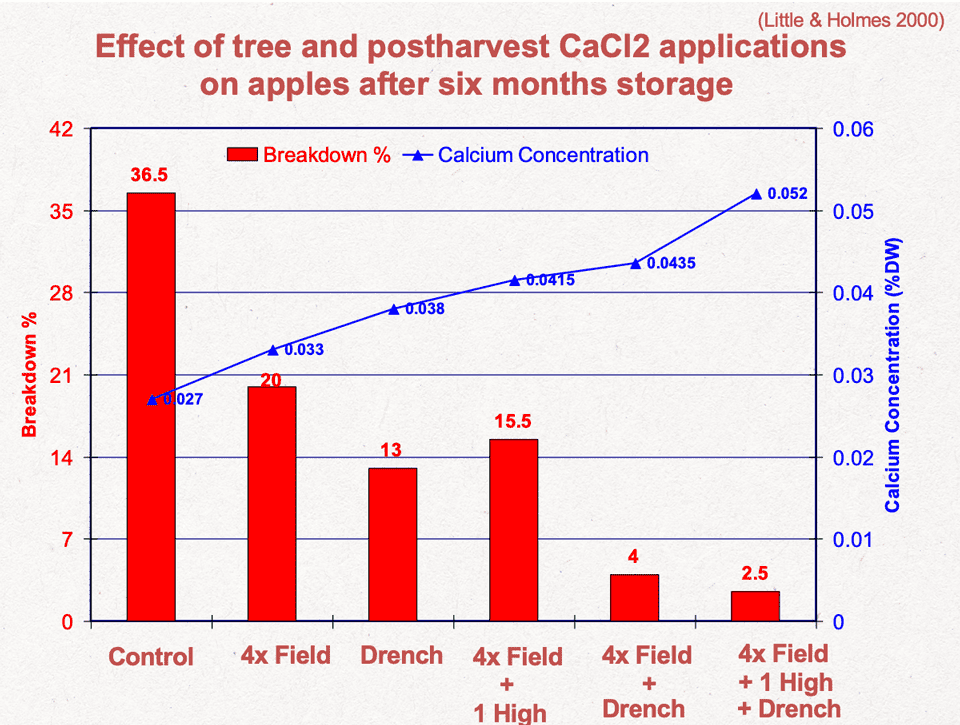
2. Eastern Washington soils are predominately calcareous so it’s not a surprise that there is enough calcium naturally to provide for any tree fruit crop. However, making this point is really not helpful because we still have plenty of bitterpit! The issue is that this soil bound calcium is not plant available!
3. Strategies used for calcium management involve a range of cultural practices. We often discuss things like irrigation management, nitrogen management, crop load management, site selection, cultivar choice, careful use of other soil fertility supplements, etc. In addition, we promote the use of long standing and well proven calcium foliar treatments, and more recently, soil applied strategies. Certainly, soil applied supplements are not “the solution” to calcium problems, but part of a broad strategy. Soil applied calcium programs have shown clear benefit, and their use is driven by observed results in the field. However, these practices have not been extensively studied by university research. For this reason, I don’t believe that our use of calcium fertilizers is going to change based on a small scale one year university trial that disputes their benefit. There is just too much evidence that calcium fertilizers are having a big impact.
Understanding the Growing System
[Editors Note: authors comments are stylized like this.]
Here is an excerpt from an article written by the same author and published in the Goodfruit Grower in April 2019 https://www.goodfruit.com/sallato-calcium-deficiencies-in-fruit/ “With adequate calcium levels in the soil, the movement to the roots occurs through mass flow. Nutrients dissolved in the soil solution will travel with the water flux generated by the plant for its transpiration and growth. Nitrogen, magnesium and boron also move mainly by mass flow, while phosphorous and potassium move mainly by diffusion, from high to low concentration, with much lower rates.” Agreed.
“In both cases, soil moisture and root volume are fundamental to facilitating nutrient movement and absorption.” Yes, so when conducting a research trial on various calcium fertilizers the volume and health of the root system and the irrigation scheduling would be critical. It would be easy to miss a treatment effect if these parameters were not addressed – not to mention the potential for variability in mineral content sampling, etc.
“Once absorbed by the root, calcium must enter the xylem, the tree’s main conductive system for calcium translocation to aerial tissues. Transport and distribution to the rest of the plant will be driven by transpiration and new growth demand (De Freitas and Mitcham, 2012).” Agreed. Xylem transport is the most important method to supply calcium to the fruit.
“New leaves and shoots have a greater water demand, thus excessive vigor will reduce calcium transport to the fruit. Green fruits are in active development and can photosynthesize,” (and transpire). “During this period, approximately four to five weeks after full bloom for apples and three weeks after full bloom for cherries, the maximum demand for cell wall calcium occurs.” Although it’s not really “demand for cell wall calcium”, this “active development” time is arguably the most efficient time for xylem delivery of calcium to fruitlets. Early in the spring when the tree is emerging from dormancy and blooming/setting fruit there are not many leaves. The fruit is in the cell division phase where calcium is critical for establishing strong connections between cells. Newly forming fruitlets compete well with leaves for transpirational flow. This concept is fundamental to our commercial growing practices. Below is a chart showing rapid calcium delivery to the fruit during this cell division or “absorption” phase.
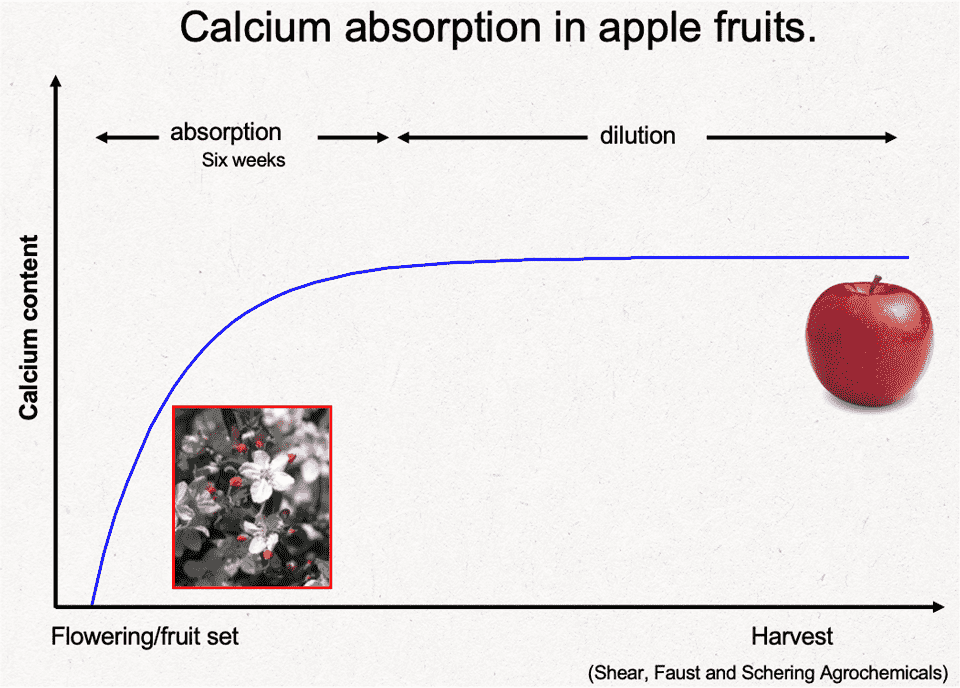
Fruit trees are deciduous. They create new leaves and shoots every year and often we “adjust” the ratio of shoots to roots each dormant season with pruning to reduce crop load and create vegetative vigor. This supports our goals managing fruit size and tree health. As well pruned trees exit dormancy in the spring (because of the disproportionally large amount of energy in the roots), it does not take long for leaves to overtake the fruit’s ability to transpire and collect calcium from the xylem. It would follow that minimal dormant pruning is appropriate where fruit condition and bitterpit have historically been a problem. Maintaining a low nitrogen and relatively high xylem sap concentration of calcium in the is clearly beneficial as well. Below is a chart developed by Penn State research that illustrates this concept very well.
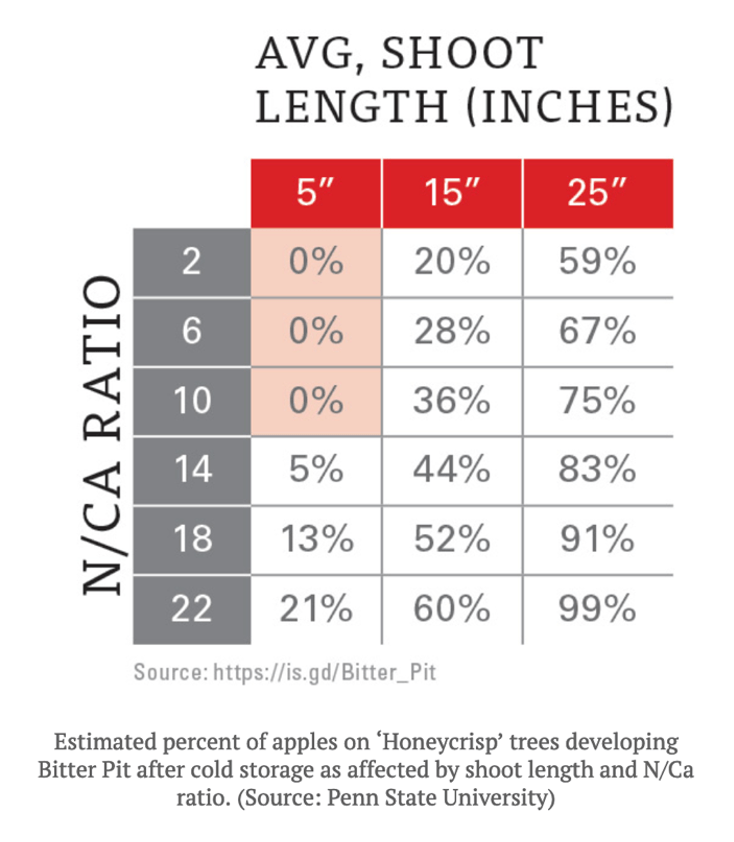
“That means that ensuring available calcium and promoting early root growth and water movement will benefit calcium absorption and allocation toward the fruit.” I’m reading that we should consider applying calcium fertilizer and deliberately promote root growth and soil biology.
Another important point is that soil temperatures are often too cool during bloom to allow for roots to grow. Exudate from actively growing roots is required for access to calcium that is chemically bound in the soil. However, free calcium in the soil solution can be delivered by mass flow as newly formed tissue (including fruit) transpires. Using a charge protected plant available calcium fertilizer would really make sense early in the spring.
“However, excessive fruit growth has shown greater incidence of deficiency disorders, possibly due to calcium dilution in the cellular space or the inability of the cell wall and membranes to contain that excessive growth. Thus, fruit size control is fundamental, particularly in susceptible varieties. Agreed. This is a vigor/crop load management issue. These both affect the amount of transpirational balance that goes to the leaves……leaf to fruit ratio. In fact, in 1986, Dr. Tom Raese showed that summer pruning (adjusting leaf to fruit ratio) reduced the incidence of cork spot in Anjou pears. Included in the chart below are data from a similar trial conducted by C.P. Harley in 1933. These concepts have been around for quite a while.
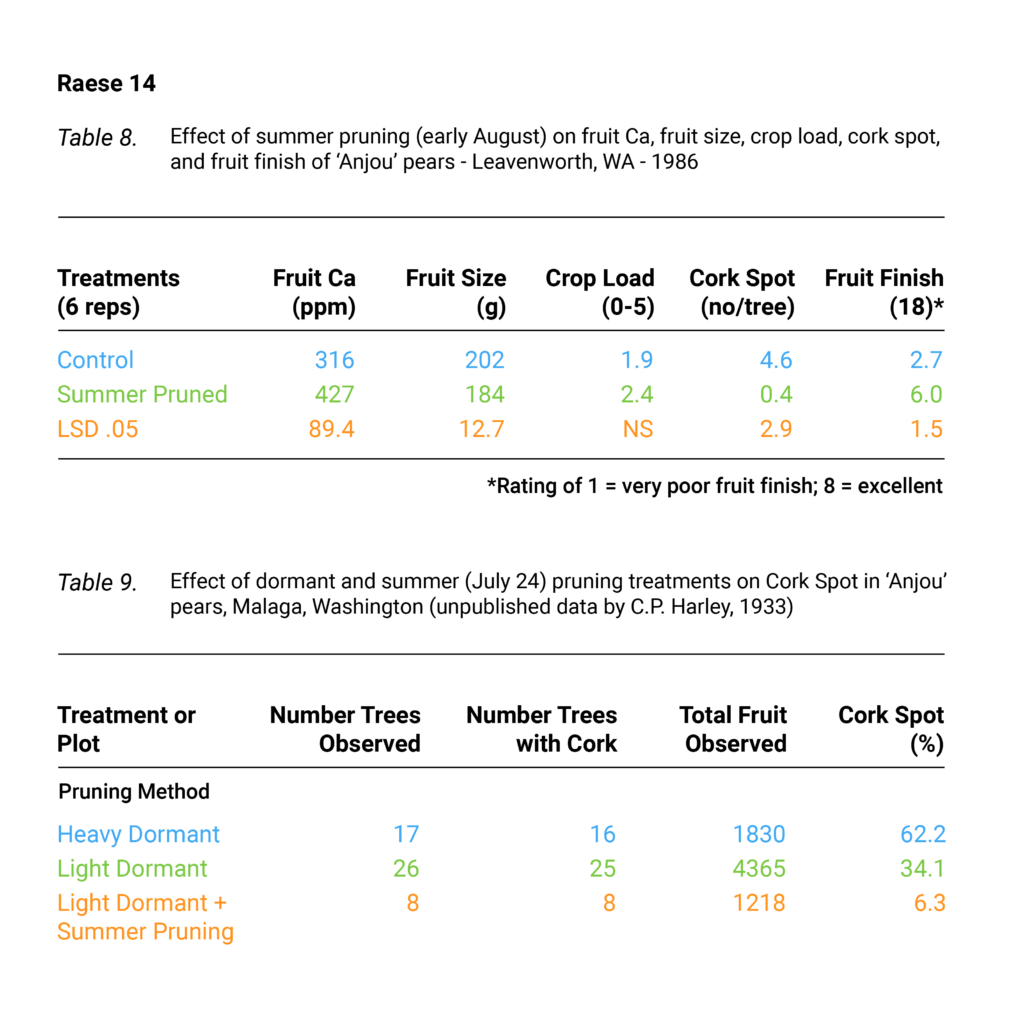
“In addition, crop load management and water restrictions during the fruit growth phase have been effective in reducing deficiency disorders.” I read that leaf to fruit ratio and controlling the rate of transpiration through irrigation management are important considerations.
“But that is not all. Nutrients can be both antagonistic and synergistic, either at a soil level for nutrient uptake or inside the plant. Calcium is no exception.”
“At the soil level, calcium competes with other cations: potassium, magnesium, sodium, manganese and ammonium. Even though the mechanism is still unclear, it is recognized that keeping adequate levels of all nutrients in the soil can prevent antagonism. In heavy soils, potassium has low mobility; keeping potassium levels in the range between 150 and 250 mg/kg will prevent antagonism.” Again, I’m reading that if we have a cation imbalance that we should consider using calcium fertilizer. In most situations though we will be successful if we ensure the cation balance in the xylem favors calcium to achieve the ends we’re looking for. Soil balance is not so important if we have a plant available source of calcium.
[End Excerpt]
I thought this article was good. And, of course it proceeded the more recent article that was based on a couple of trials conducted in north Pasco. Again, what is driving the interest in soil applied calcium programs are actual results in commercial agriculture. What follows is a collection of some of the data Redox has on soil applied calcium and it’s benefits in various crops.
Redox Results
Below is the result of a controlled study using soil applications of radio labeled calcium and the relative amounts in the aerial parts of the plant (cucumber). It is clear that soil applications are effective. The form of calcium matters. There is a clear increase in the amount of calcium in the xylem.
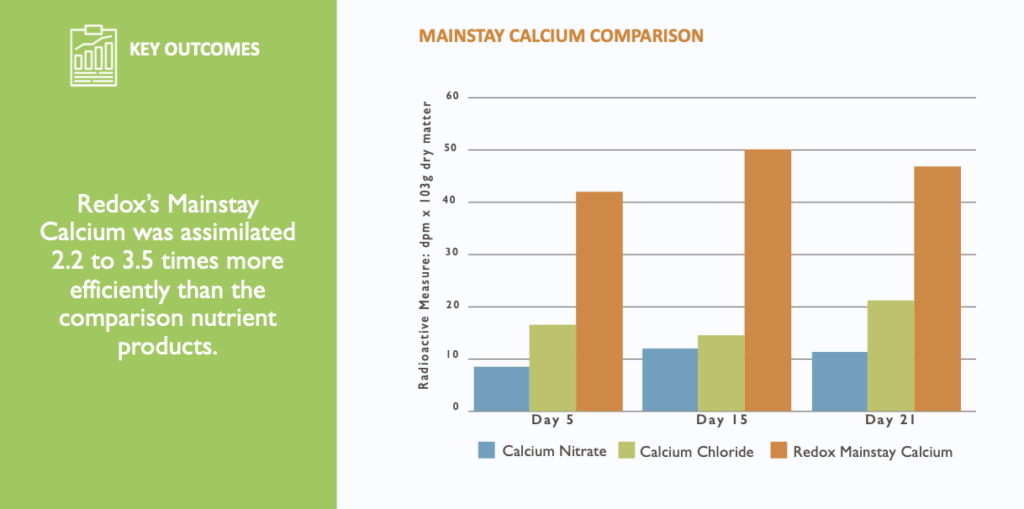
Below is another comparison in strawberry. Soil applications are beneficial in any form. Plant available form requires much less to produce the desired marketable yield.
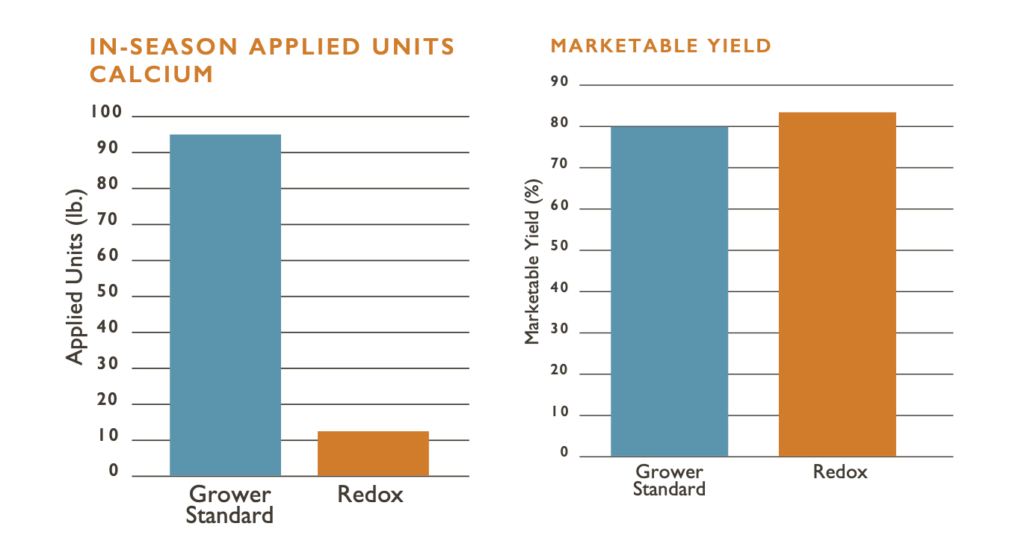
Honeycrisp apples and cortex content of calcium. There is a strong correlation to soil applications of plant available calcium and the incidence of bitterpit.

These photos are great example of what is driving soil applied calcium in the field here in Washington. Less fruit loss in the field. Growers can actually see the benefits in the orchard and in their packouts as well. No question.
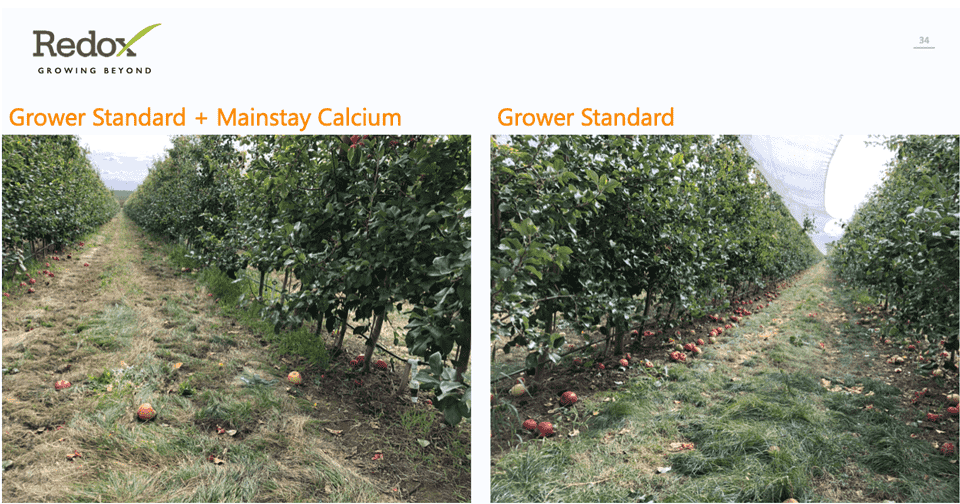
What about foliar calcium? This has been studied extensively by Dr. Tom Raese, Dr Lee Kalcsits and others. There is consistent agreement that foliar calcium supplements are beneficial. Here is an excerpt from a controlled study by Kalcsits, et. al. and its conclusion:
“The stable isotope, 44Ca, provides the opportunity for targeted tracer experiments conducted under field conditions and provides a quantitative approach for determining the effectiveness of foliar Ca applications. The findings in this experiment support current recommendations that frequent, low-concentration applications throughout the entire fruit development period result in consistent Ca absorption into apple fruit.”
Click here to read more about this controlled study and its conclusion.
Final Thoughts
One dynamic to the calcium model that is not really well understood is the incredibly small amount that is in the fruit at harvest. While it’s not uncommon for several hundred pounds of calcium to be applied per acre, the amount removed with the apple crop is only a few pounds per acre. So, if the calcium applied reaches the plant at all, most is captured in the leaves or woody tissues. Only small amounts reach the fruit.
The point of mentioning this is that there is clearly a huge gap in our understanding of how to deliver calcium to fruit efficiently in our modern horticultural systems. This creates an incredible opportunity for developing programs that optimize application timing, the use of specialized calcium products, well controlled fertility inputs, and careful vigor, cropload and irrigation management. We often focus on the Honeycrisp apple when discussing strategies for improving outcomes with calcium nutrition. Indeed, if we are successful with solving calcium problems in Honeycrisp, the strategy developed will be useful for other cultivars. There is absolutely no question that we have made great progress improving outcomes in Honeycrisp with the use of soil applied calcium, but there is still room for improvement. I believe that we are on the correct path.
Questions? Want to know more about Calcium Nutrition in Tree Fruit?
Subscribe to receive our Redox Bio-Nutrients updates